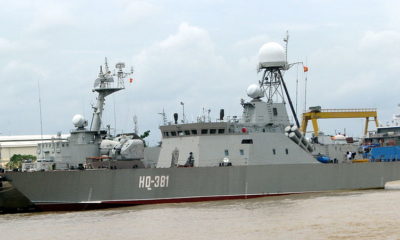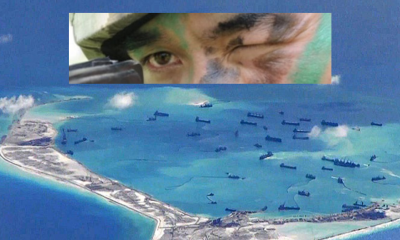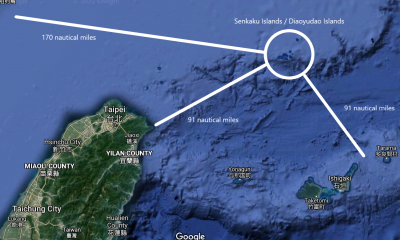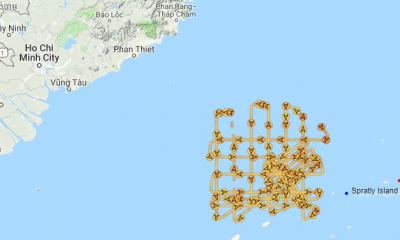Phan Van Song, Nguyen Trinh Don, Nguyen Luong Hai Khoi
Examining the “historical evidence” for China’s sovereignty over the South China Sea islands (Part 4: “China was the first to exercise jurisdiction over the Nánshā Islands”)
One of the earliest documents that CMOFA cites to support China’s jurisdiction exercise claim is the Yuándài Jiāngyù Túxù (元代疆域图叙, Map of the Territory of the Yuán Dynasty), which it claims to contain the Paracels and the Spratlys (we have no access to this map and so cannot verify CMOFA’s statement) CMOFA also mentions that Dìlǐ Zhì (地理志, Geography Section) in Yuán Shǐ (元史, History of the Yuán Dynasty) includes the Spratly Islands within the Yuán Dynasty’s domain. Nevertheless, Dà Yuán Yītǒng Zhì (大元一统志, Comprehensive Geography of the Great Yuán), Dà Míng Yītǒng Zhì (大明清一统志, Comprehensive Geography of the Great Míng), Qīng Shǐgǎo (清史稿, History of Qīng), and several much later maps of the Qīng Dynasty do not have any reference to the Spratly Islands. CMOFA’s claim about the Spratlys in Yuán Shǐ thus raises skepticism about its reliability. Even if Yuán Shǐ indeed states that the Spratlys were part of the Yuán Dynasty’s territory, the absence of the Spratlys in later historical documents shows that the Chinese State did not have the will to consistently and continuously include these islands into its domain.
CMOFA claims in its statements in English that the Spratly Islands were marked by five Qīng Dynasty’s maps, namely (1) Map of Administrative Divisions of the Whole China of the 1724 Map of Provinces of the Qing Dynasty, (2) Map of Administrative Divisions of the Whole China of the 1755 Map of Provinces of the Imperial Qing Dynasty, (3) 1767 Map of Unified China of the Great Qing for Ten Thousand Years, (4) 1810 Topographical Map of Unified China of the Great Qing for Ten Thousand Years, and (5) 1817 Map of Unified China of the Great Qing for Ten Thousand Years.
A closer look at the titles of these maps in Chinese begs a different understanding. For example, map (1) is the Tiānxià Zǒngyútú (天下总舆图, the World [General] Map) in the 1724 Qīng Zhíshěng Fēntú (清直省分图, Map of Provinces of the Qīng Dynasty), and map (2) is the Tiānxià Zǒngyútú (天下总舆图, the World [General] Map) in the 1755 Huáng Qīng Gè Zhíshěng Fēntú (皇清各直省分图, Map of Provinces of the Imperial Qing Dynasty). It should be noted that these two maps contain the word tiānxià (天下: “under heaven”, which means the whole world in a broader sense or whole China in a narrower sense) in their titles (Zǒngyútú means “general map’). This indicates that they were meant to be the world maps or maps of China-and-its-vassal-states (the whole China as traditionally perceived, not China proper). Therefore, it is misleading to translate Tiānxià Zǒngyútú as “A Map of Administrative Divisions of the Whole China” as “Whole China” could be taken to be China proper while nowhere in the original titles exists “Administrative Divisions”.
The same should be applied for maps (3) and (5). The original title of the map (3), Dà Qīng Wànnián Yītǒng Tiānxià Quántú (大清万年一统天下全图, The Complete Map of the Whole [Unified] World in the Qing Dynasty [for ten thousand years]), contains the word Tiānxià. Similarly, map (5) is Dà Qīng Yītǒng Tiānxià Quántú (大清一统天下全图, The Complete Map of the Whole [Unified] World of the Qing Dynasty), also containing the word Tiānxià. CMOFA’s translations “Map of Unified China of the Great Qing for Ten Thousand Years” cannot be accepted unless “Unified China” is understood as Tiānxià in the above meaning (surprisingly the phrase for ten thousand years (Wànnián) in the CMOFA’s title for map (5) seems to come out from nowhere) As a result, it is not surprising that these four maps all contain the Spratlys and even other islands and reefs in the South China Sea or the other seas in the world.
As for Map (4), the 1810 Dà Qīng Wànnián Yītǒng Dìliàng Quántú (大清万年一统地理全图), the CMOFA’s translation “the 1810 Topographical Map of Unified China of the Great Qing for Ten Thousand Years” is accurate enough although it is not clear whether this map (without “tiānxià”) marks the Spratlys as Chinese territory.
CMOFA also backs up its arguments by quoting the epitaph of Qiān Shìchái (佥事柴), Hăinán’s Commander of Defence (海南卫指挥, Hǎinán Wèi Zhǐhuī) under the Míng Dynasty, (no details of his time of service are provided). [1] The quote reads
“Guǎngdōng bīn dà hǎi, hǎi wài zhū guó jiē nèi shǔ, gōng tǒng bīng wàn yú, jù jiàn wǔ shí sou, xún luó hǎi dào jǐ wàn lǐ” (广东濒大海, 海外诸国皆内属, 公统兵万余, 巨舰五十艘, 巡逻海道几万里),
And literally means
“Guăngdōng is adjacent to the grand sea, the states beyond the Sea all internally belong [to the Míng State], [Commander Qiān] led more than ten thousand soldiers [and] 50 huge warships, patrolled tens of thousands of lǐ of marine routes”.
CMOFA translates the quote into English as “Guangdong is adjacent to the grand South China Sea, and the territories beyond the sea all internally belong to the Ming State. General Qian led more than ten thousand soldiers and 50 huge ships to patrol tens of thousands of li on the South China Sea” (emphasis added).
The words emphasized here from the CMOFA’s version are different from the literal translation and are misleading. Translating “zhūguó” (“all countries” – zhū 诸: all, and guó 国: country/nation/state) as “all territories” is completely unacceptable as readers may take guó as “lands”, “islands”, or “reefs” instead of its true meaning. Here CMOFA deliberately tailors translated words to suit its arguments that all the islands, rocks, and reefs “beyond the sea” belong to China, making readers misunderstand that Qiān did exercise his patrol to the Paracels, the Macclesfield Banks, the Spratlys, and Scarborough Shoal. This would be downright illogical unless there were any words in the text explicitly showing that Qiān traveled to the Spratlys (there are actually not!), or China had convincing evidence that these islands belonged to Hăinán (none so far!). Interestingly, a simple calculation for the travel mileage in Qiān’s epitaph makes it clear that Qiān had only had to make about 14 rounds or so surrounding Hăinán’s coast (approximately 750 km) during his long career of defending the Hăinán and China’s southern coast to be able to claim that he had traveled “tens of thousands of lǐ” (里, one Chinese mile, roughly equal to 500 m). Furthermore, the inscription on ancient epitaphs in East Asia almost always have some degree of beautification and even exaggeration in honor of the deceased. Therefore, grandeur words such as “all states” and “tens of thousands” should not be taken as true facts. It is, therefore, totally unconvincing to use this epitaph as evidence that Qiān went tens of thousands of lǐ from Hăinán to the far-flung uninhabited islands, especially Spratly Islands which are more than 800 km away and still considered as dangerous areas for ships even centuries later, to exercise China’s jurisdiction!
CMOFA presents other examples of China’s jurisdiction exercise in the Spratly Islands by mentioning that China had strongly protested against the French occupation of nine islands in the archipelago in 1933 and that China took over and erected marks of sovereignty on the Spratly Islands in 1946 following the 1943 Cairo Communiqué and the 1945 Potsdam Declaration. In reality, China only demanded the French authorities advise the names and coordinates of the occupied islands in 1933 without any further actions. This cannot be considered as an act of protest and by no means a “strong protest” as CMOFA states. Also, when Japan claimed and invaded the Spratly Islands in 1936, only France, exercising sovereignty on behalf of Viet Nam, opposed Japan’s actions while China did not make any protests. After the conclusion of World War II, China “took over” the Spratlys despite the fact that they are south of the 16th parallel and were entrusted to Great Britain by the Allies. Although CMOFA invokes the 1943 Cairo Communiqué and the 1945 Potsdam Declaration to justify this illegal occupation, these documents in no way state that the Paracels and the Spratlys belong to China. [2] Therefore, the 1946 actions by China on these islands were not an exercise of jurisdiction but a violation of other countries’ sovereignty and international agreements.
CMOFA also uses many other maps to demonstrate China’s jurisdiction in the South China Sea. However, when joining the Government of China’s effort to review maps and names of islands, reefs, islets, and shoals in the South China Sea, Chinese scholars have to admit that “At the beginning of the 1930s, most Chinese maps were reproductions or based upon older maps. New fieldwork had not been undertaken for many years. These maps contained errors and some, without analysis, were copies of foreign-produced maps. As a result, Chinese ocean and land boundaries were not consistently shown on the various maps. This was obviously problematic for China as regards its sovereignty in the South China Sea”. [3] This indicates a lack of will from the Chinese State in the early days to exercise its supposed sovereignty in the South China Sea even just by maps. Furthermore, even if China’s reviewing efforts were successful, naming and/or re-naming places is not necessarily an act of exercising jurisdiction. If a State could exercise and/or acquire sovereignty over geological features simply by naming them, the Western States, well known for naming numerous geographical features, would be entitled to sovereignty rights everywhere around the globe, including the South China Sea.
Conclusion
CMOFA has indeed been repeatedly making use of ample historical documents, both nonfiction and fiction, and even including narrative accounts and a memorial epitaph. To turn these texts and maps into “historical evidence” to support its claim for sovereignty over most of the South China Sea and its islands, China has in many cases employed deceptive, self-serving maneuvers such as quote cherry-picking, mistranslating, and misinterpreting. These confusions are more often than not obscured by the fact that the Chinese language is still unfamiliar with a significant portion of international scholars, observers, and commentators. China’s authorities seem to take full advantage of this fact as well as the ancient Chinese texts’ nature to distort contexts and add punctuation arbitrarily to tailor ancient words to modern arguments (old Chinese writings have neither capital characters nor punctuation marks in general). Nevertheless, a careful evaluation of these documents can reveal that they are either of no value in supporting China’s position and, in some cases, actually against it. Therefore, China’s statement that it has ample and solid historical evidence to support its sovereignty over the South China Sea, particularly the Spratly Islands, is merely a statement – and an unfounded one at that.
We would like to conclude with a recommendation by Lǐ Jīnmíng, a Chinese expert on the South China Sea, to the Government of China that his country should start accumulating sufficient evidence to prove that the South China Sea belongs to China since it may not be able to refuse international arbitration indefinitely. [4] However genuine Lǐ’s suggestion may be, there is not much the Government of China can do when international law and almost all historical official records from China and elsewhere simply do not agree with China’s claims.
Notes
[1] The Míng dynasty, officially the Great Míng, was the ruling dynasty of China from 1368 to 1644 following the collapse of the Mongol-led Yuán dynasty.
[2] The 1943 Cairo Communiqué states that “all the territories Japan has stolen from the Chinese, such as Manchuria, Formosa, and The Pescadores, shall be restored to the Republic of China”, and the 1945 Potsdam Declaration reads: “The terms of the Cairo Declaration shall be carried out and Japanese sovereignty shall be limited to the islands of Honshu, Hokkaido, Kyushu, Shikoku and such minor islands as we determine”.
[3] See Li Jinming & Li Dexia, The Dotted Line on the Chinese Map of the South China Sea: A Note, The School of Southeast Asian Studies Xiamen University Xiamen, Fujian, China, 2002, available at here.
[4] Zhang Jie, et al., [the US forcefully pushes internationalization of the South China Sea issue, Yang Jiechi uses seven arguments to counter Hillary’s “incorrect points”]. Dongfang Zaobao, July 26, 2010.
Phan Văn Song & Nguyễn Trịnh Đôn
Examining the “historical evidence” for China’s sovereignty over the South China Sea islands (Part 1: “China was the first to discover and name the Nánshā Islands”)
Examining the “historical evidence” for China’s sovereignty over the South China Sea islands (Part 2: Chinese official maps and historical/geographical books against China’s claim in the South China Sea)
Examining the “historical evidence” for China’s sovereignty over the South China Sea islands (Part 3: “China was the first to have development activities on the Nánshā Islands”)
Examining the “historical evidence” for China’s sovereignty over the South China Sea islands (Part 4: “China was the first to exercise jurisdiction over the Nánshā Islands”)

 Politics & Economy3 years ago
Politics & Economy3 years ago
 Society & Culture4 years ago
Society & Culture4 years ago
 ARCHIVES4 years ago
ARCHIVES4 years ago
 Politics & Economy3 years ago
Politics & Economy3 years ago
 Politics & Economy4 years ago
Politics & Economy4 years ago
 Politics & Economy3 years ago
Politics & Economy3 years ago
 Politics & Economy4 years ago
Politics & Economy4 years ago
 ARCHIVES3 years ago
ARCHIVES3 years ago















